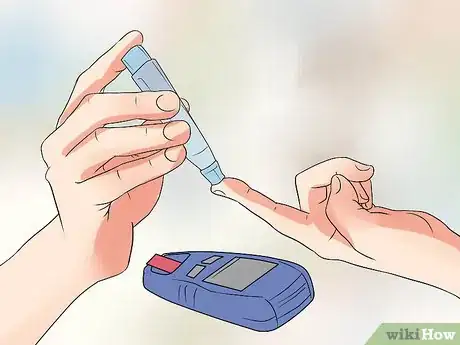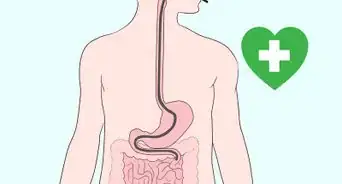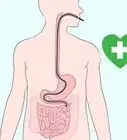This article was medically reviewed by Amy Chow. Amy Chow is a Registered Dietitian and the Founder of Chow Down Nutrition, a family and child nutrition consulting service in British Columbia (BC), Canada. With over nine years of experience, Amy has a special interest in pediatric nutrition, food allergy management, and eating disorder recovery. Amy holds a Bachelor’s degree in Nutritional Sciences from McGill University. She gained her clinical experiences at residential and outpatient eating disorder treatment programs as well as for BC Children’s Hospital before starting her own business. She has been featured on Find BC Dietitians, Dietitians of Canada, Food Allergy Canada, Recovery Care Collective, Parentology, Save on Foods, National Eating Disorder Information Centre (NEDIC), and Joytv.
There are 9 references cited in this article, which can be found at the bottom of the page.
wikiHow marks an article as reader-approved once it receives enough positive feedback. In this case, 100% of readers who voted found the article helpful, earning it our reader-approved status.
This article has been viewed 666,349 times.
Lactose intolerance is the inability to digest lactose, which is the main sugar found within milk and other dairy products.[1] It's caused by a complete lack or shortage of lactase, which is the enzyme needed to digest lactose sugar in the small intestine. Lactose intolerance is not considered a life-threatening condition, although it can cause significant stomach and intestinal symptoms (bloating, abdominal pain, flatulence), and restrict dietary choices. Many adults are lactose intolerant without having other medical conditions; however, be aware that many other diseases and conditions also cause gastrointestinal (GI) problems, so recognizing the constellation of lactose intolerance symptoms is helpful.
Steps
Recognizing the Symptoms of Lactose Intolerance
-
1Pay attention to GI symptoms. As with many conditions, trying to understand if your physical experience is unusual or out of the ordinary is sometimes difficult to determine. For example, if a person always has GI issues after meals, then that is their established normal and they likely assume others feel the same way. But experiencing bloating, flatulence (passing gas), cramps, nausea and loose stool (diarrhea) after meals is not considered normal and always represents signs of digestive problems.[2] [3]
- A variety of conditions and diseases cause similar GI symptoms and diagnosing can be tricky, but the first step is realizing that your digestive experience is not normal and it needn't be accepted as unavoidable.
- Lactase splits lactose into two smaller sugars, glucose and galactose, which are absorbed by the small intestine and used by the body as energy.[4]
- Not all people with lactase deficiency have digestive or GI symptoms — they produce low levels, but it's enough to handle their dairy (lactose) consumption.
-
2Try to link your symptoms with consuming dairy products. The typical signs and symptoms of lactose intolerance (bloating, abdominal pain, passing gas and diarrhea) often begin between 30 minutes to two hours after eating foods or drinking beverages that contain lactose.[5] As such, try to link your GI symptoms to consuming dairy products. Start first thing in the morning by eating a breakfast devoid of any lactose (read labels if you're unsure) and see how you feel. Contrast that to eating lunch with some dairy, such as cheese, yogurt and/or milk. If there is a significant difference in how your GI system feels, then you may very well be lactose intolerant.
- If you feel bloated and flatulent after both meals, then you may have a stomach or intestinal issue such as inflammatory bowel disease or Crohn's disease.
- If you feel pretty good after both meals, then maybe you have a food allergy to something else in your diet.
- This sort of approach is usually called an elimination diet, meaning that you eliminate dairy products from your diet in efforts to narrow down the cause of your GI problems.
Advertisement -
3Distinguish between lactose intolerance and a milk allergy. Lactose intolerance is essentially an enzyme deficiency disease, which leads to an undigested sugar (lactose) ending up in the large intestine (colon). Once there, normal intestinal bacteria feast on the sugar and produce hydrogen gas (and some methane) as a byproduct, which explains the bloating and flatulence associated with lactose intolerance.[6] In contrast, a milk allergy is an abnormal response by the immune system to milk products and often occurs within a few minutes of being exposed to the causative protein (casein or whey).[7] Symptoms of a milk allergy can include wheezing, hives (severe rash), swollen lips/mouth/throat, runny nose, watery eyes, vomiting and digestive problems.
- Cow milk allergy is one of the most common allergies that affects children.
- Cow's milk is the usual cause of an allergic reaction, but milk from sheep, goats and other mammals can also trigger a reaction.
- Adults with hay fever or other food allergies are more likely to have a negative reaction to milk products.
-
4Realize how lactose intolerance is linked to ethnicity. Although the amount of lactase produced in your small intestine becomes less with advancing age, it is also linked to your genetics. In fact, the prevalence of lactase deficiency in certain ethnic groups is quite high. For example, about 90% of Asians and 80% of African-Americans and Native Americans are lactose intolerant.[8] The condition is least common among peoples of northern European ancestry. As such, if you're of Asian or African-American ancestry and commonly experience GI symptoms after meals, there's a very high probability it's caused by lactose intolerance.
- Lactose intolerance is unusual in all babies and infants, regardless of ethnicity — it's typically a condition that appears in adulthood.
- However, babies born prematurely may have reduced ability to produce lactase because of their underdeveloped intestines.
Confirming Lactose Intolerance
-
1Get a hydrogen breath test. The most common test for the diagnosis of lactase deficiency is called a hydrogen breath test.[9] This test is done at your doctor's office or an outpatient clinic, but typically after you've experimented with an elimination diet. The hydrogen breath test involves drinking a sweet liquid containing lots of lactose (25 grams). Your doctor then measures the amount of hydrogen gas in your breath at regular intervals (every 30 minutes). With people who can digest lactose, very little or no hydrogen is detected; however, for lactose intolerant people, the hydrogen reading is much higher because the sugar ferments in their colons via bacteria and produces the gas.
- The hydrogen breath test is a great way to identify lactose intolerance because it's highly reliable and very convenient.
- The test typically requires you to fast the night before and avoid smoking.
- Using too much lactose on some people can give false positives, as can bacterial overgrowth in their colons.
-
2Take a blood glucose/lactose tolerance test. The lactose tolerance test is a blood test used to gauge your body's reaction to consuming high levels of lactose (usually 50 grams).[10] A fasting serum glucose is taken by your doctor as a baseline measurement and then compared to readings taken one to two hours after drinking the lactose beverage. If your blood glucose level doesn't increase by 20 g/dL above the baseline within that time frame, it means your body isn't properly digesting and/or absorbing lactose.
- The blood glucose/lactose tolerance test is an older method of diagnosing lactose intolerance and not performed nearly as frequently as the hydrogen breath test, but it can also be helpful.
- The blood glucose/lactose tolerance test has a sensitivity of 75% and a specificity of 96%.[11]
- False-negative results occur with diabetes and bacterial overgrowth in the intestines.
-
3Have a stool acidity test done. Undigested lactose creates lactic acid and other fatty acids in your colon, which end up in your feces.[12] A stool acidity test, which is typically used on infants and young children, can detect these acids from a stool sample. The child is given a small amount of lactose and then several consecutive stool samples are taken and tested for higher than normal acidity levels. A young child may also have glucose in their stool as a result of undigested lactose.
- For infants and children who can't take other lactose intolerance tests, a stool acidity test is a good alternative.
- Even though this test is effective, the breath test is usually preferred due to its ease and convenience.
Expert Q&A
-
QuestionWhat are the worst foods to eat if you are lactose intolerant?
 Shari Forschen, NP, MAShari Forschen is a Registered Nurse at Sanford Health in North Dakota. Shari has worked in healthcare since 1996 and her expertise lies in acute care bedside nursing on a medical oncology floor. She received her degree from Medcenter one College of Nursing in 2003 and her Family Nurse Practitioner Masters from the University of North Dakota in 2014. Shari is a member of the American Nurses Association.
Shari Forschen, NP, MAShari Forschen is a Registered Nurse at Sanford Health in North Dakota. Shari has worked in healthcare since 1996 and her expertise lies in acute care bedside nursing on a medical oncology floor. She received her degree from Medcenter one College of Nursing in 2003 and her Family Nurse Practitioner Masters from the University of North Dakota in 2014. Shari is a member of the American Nurses Association.
Master's Degree, Nursing, University of North Dakota If you are lactose intolerant, all dairy-based products will cause significant stomach and intestinal pain.
If you are lactose intolerant, all dairy-based products will cause significant stomach and intestinal pain. -
QuestionHow long do the stomach pains last for because mine has been going for 7 hours now?
 Shari Forschen, NP, MAShari Forschen is a Registered Nurse at Sanford Health in North Dakota. Shari has worked in healthcare since 1996 and her expertise lies in acute care bedside nursing on a medical oncology floor. She received her degree from Medcenter one College of Nursing in 2003 and her Family Nurse Practitioner Masters from the University of North Dakota in 2014. Shari is a member of the American Nurses Association.
Shari Forschen, NP, MAShari Forschen is a Registered Nurse at Sanford Health in North Dakota. Shari has worked in healthcare since 1996 and her expertise lies in acute care bedside nursing on a medical oncology floor. She received her degree from Medcenter one College of Nursing in 2003 and her Family Nurse Practitioner Masters from the University of North Dakota in 2014. Shari is a member of the American Nurses Association.
Master's Degree, Nursing, University of North Dakota It depends on if you are intolerant to lactose or if your have gastrointestinal flu (gastritis). If you know that you are intolerant to lactose, avoidance is best method of treating this dietary problem. You will have to find other sources of calcium to get the necessary nutrients for your bones.
It depends on if you are intolerant to lactose or if your have gastrointestinal flu (gastritis). If you know that you are intolerant to lactose, avoidance is best method of treating this dietary problem. You will have to find other sources of calcium to get the necessary nutrients for your bones.
Warnings
- Lactose intolerance causes symptoms that mimic those of other more serious GI conditions, so always consult with a doctor instead of attempting to self-diagnose.⧼thumbs_response⧽
- It is important that if you have lactose intolerance and eliminate dairy products you still get enough calcium and other nutrients found in dairy. Talk to your doctor if it is necessary for you to supplement your calcium and vitamin D in particular.[15]⧼thumbs_response⧽
References
- ↑ https://my.clevelandclinic.org/health/diseases_conditions/hic_Lactose_Intolerance
- ↑ http://www.niddk.nih.gov/health-information/health-topics/Anatomy/your-digestive-system/Pages/anatomy.aspx
- ↑ http://www.mayoclinic.org/diseases-conditions/lactose-intolerance/basics/symptoms/con-20027906
- ↑ http://www.medicinenet.com/lactose_intolerance/article.htm
- ↑ https://my.clevelandclinic.org/health/diseases_conditions/hic_Lactose_Intolerance
- ↑ http://www.medicinenet.com/lactose_intolerance/page2.htm
- ↑ http://www.mayoclinic.org/diseases-conditions/milk-allergy/basics/definition/con-20032147
- ↑ https://my.clevelandclinic.org/health/diseases_conditions/hic_Lactose_Intolerance
- ↑ https://my.clevelandclinic.org/health/diseases_conditions/hic_Lactose_Intolerance
- ↑ http://emedicine.medscape.com/article/187249-workup
- ↑ http://emedicine.medscape.com/article/187249-workup
- ↑ http://www.niddk.nih.gov/health-information/health-topics/digestive-diseases/lactose-intolerance/Pages/facts.aspx
- ↑ https://my.clevelandclinic.org/health/diseases_conditions/hic_Lactose_Intolerance
- ↑ https://online.epocrates.com/diseases/798/lactase-deficiency#treatment-approach
- ↑ https://online.epocrates.com/diseases/798/lactase-deficiency#treatment-approach
About This Article
Lactose intolerance happens when your digestive tract doesn't have enough enzymes to digest milk products, and by looking for some of the classic signs, you can recognize if you have it. Keep an eye out for gastrointestinal problems after eating a meal. If you have bloating, gassiness, cramps, nausea, and diarrhea, you might be lactose intolerant. If you’re experiencing any of these symptoms, try to think about whether you may have had any dairy products. Symptoms of lactose intolerance usually start within 30 minutes to 2 hours after eating or drinking dairy products. If you haven't had any dairy recently, but you're having symptoms, you may have a different intestinal issue, such as Crohn's disease or irritable bowel syndrome. See your doctor to get an official diagnosis. For tips about how to distinguish between lactose intolerance and a milk allergy, keep reading!


































































Medical Disclaimer
The content of this article is not intended to be a substitute for professional medical advice, examination, diagnosis, or treatment. You should always contact your doctor or other qualified healthcare professional before starting, changing, or stopping any kind of health treatment.
Read More...